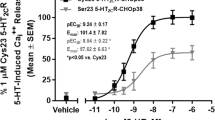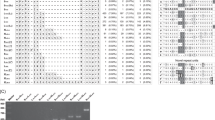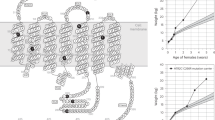Abstract
A human serotonin (5-HT)2C receptor gene polymorphism leads to the substitution of cysteine for serine at codon 23 (Cys23Ser); the frequency of the Ser23 allele in unrelated Caucasians is approximately 0.13. In the present study, we assessed whether Cys23Ser could affect receptor function. The two alleles were functionally compared following expression in COS-7 cells. The constitutive activity of the receptor in an in situ reconstitution system was also evaluated following expression of each allele in Sf9 cells. Using radioligands, Ser23-expressed membranes showed reduced high-affinity binding to meta-chlorophenylpiperazine (m-CPP) and 5-HT. Although the amplitude of the 5-HT-induced intracellular Ca2+ peak did not differ between the alleles, Ser23 required higher 5-HT concentrations to elicit the same response. These differences might be due to more extensive desensitization in the Ser23 form. In the in situ reconstitution system, the 5-HT2C receptor displayed considerable constitutive activity, with the Ser23 allele being significantly higher in this regard than the Cys23 form. After prolonged serum deprivation in order to resensitize the receptor, four of the 15 cells expressing Ser23 showed abnormally higher m-CPP-induced sensitivity of the Ca2+ response. These results indicate that the Ser23 allele may be constitutively more active than Cys23. Thus, Ser23 appears to be an abundant candidate allele capable of directly influencing inter-individual variation in behavior, susceptibility to mental disorder, and response to drugs including atypical antipsychotic and some antidepressant drugs that are potent 5-HT2C inverse agonists or antagonists.
This is a preview of subscription content, access via your institution
Access options
Subscribe to this journal
Receive 12 print issues and online access
$259.00 per year
only $21.58 per issue
Buy this article
- Purchase on Springer Link
- Instant access to full article PDF
Prices may be subject to local taxes which are calculated during checkout





Similar content being viewed by others
References
Roth BL, Willins DL, Kristiansen K, Kroeze WK . 5-Hydroxytryptamine2-family receptors (5-hydroxytryptamine2A, 5- hydroxytryptamine2B, 5-hydroxytryptamine2C): where structure meets function. Phar0macol Ther 1998; 9: 231–257.
Tecott LH, Sum LM, Akana SF, Strack AM, Lowenstein DH, Dallman MF et al. Eating disorder and epilepsy in mice lacking 5-HT2C serotonin receptors. Nature 1995; 374: 542–546.
Tecott LH, Logue SF, Wehner JM, Kauer JA . Perturbed dentate gyrus function in serotonin 5-HT2C receptor mutant mice. Proc Natl Acad Sci USA 1998; 95: 15026–15031.
Nonogaki K, Strack AM, Dallman MF, Tecott LH . Leptin-independent hyperphagia and type 2 diabetes in mice with a mutated serotonin 5-HT2C receptor gene. Nat Med 1998; 4: 1152–1156.
Vickers SP, Clifton PG, Dourish CT, Tecott LH . Reduced satiating effect of D-fenfluramine in serotonin 5-HT(2C) receptor mutant mice. Psychopharmacology 1999; 143: 309–314.
Charney DS, Woods SW, Goodman WK, Heninger GR . Serotonin function in anxiety. II Effects of the serotonin agonist mCPP in panic disorder patients and healthy subjects. Psychopharmacology (Berlin) 1987; 92: 14–24.
Hollander E, Fay M, Cohen B, Campeas R, Gorman JM, Liebowitz MR . Serotonergic and noradrenergic sensitivity in obsessive compulsive disorder: behavioral findings. Am J Psychiatry 1988; 145: 1015–1018.
Benkelfat C, Murphy DL, Hill JL, George DT, Nutt D, Linnoila M . Ethanol-like properties of the serotonergic agonist m-chlorophenylpiperazine in chronic alcoholic patients. Arch Gen Psychiatry 1991; 48: 383.
Joseph-Vanderpool JR, Jacobsen FM, Murphy DL, Hill JL, Rosenthal NE . Seasonal variation in behavioral responses to m-CPP in patients with seasonal affective disorder and controls. Biol Psychiatry 1993; 33: 496–564.
Cusack B, Nelson A, Richelson E . Binding of antidepressants to human brain receptors: focus on newer generation compounds. Psychopharmacology (Berlin) 1994; 114: 559–565.
Egan CT, Herrick-Davis K, Teitler M . Creation of a constitutively activated state of the 5-hydroxytryptamine2A receptor by site-directed mutagenesis: inverse agonist activity of antipsychotic drugs. J Pharmacol Exp Ther 1998; 286: 85–90.
Rauser L, Savage JE, Meltzer HY, Roth BL . Inverse agonist actions of typical and atypical antipsychotic drugs at the human 5-hydroxytryptamine(2C) receptor. J Pharmacol Exp Ther 2001; 299: 83–89.
Meltzer HY . An overview of the mechanism of action of clozapine. J Clin Psychiatry 1994; 55: 47–52.
Segman RH, Heresco-Levy U, Finkel B, Inbar R, Neeman T, Schlafman M et al. Association between the serotonin 2C receptor gene and tardive dyskinesia in chronic schizophrenia: additive contribution of 5-HT2Cser and DRD3gly alleles to susceptibility. Psychopharmacology (Berlin) 2000; 152: 408–413.
Lappalainen J, Zhang L, Dean M, Oz M, Ozaki N, Yu D et al. Identification, expression and pharmacology of a Cys23-Ser23 substitution in the human 5-HT2C receptor gene (HTR2C). Genomics 1995; 27: 274–279.
Zhang R, Buczko E, Dufau ML . Requirement of cysteine residues in exons 1–6 of the extracellular domain of the luteinizing hormone receptor for gonadotropin binding. J Biol Chem 1996; 271: 5755–5760.
Jordan BA, Devi LA . G-protein-coupled receptor heterodimerization modulates receptor function. Nature 1999; 399: 697–700.
Hurley JH, Bloem LJ, Pavalko F, Liu J, Tian M, Simon JR et al. Structure–function studies of the eighth hydrophobic domain of a serotonin receptor. J Neurochem 1999; 72: 413–421.
Lappalainen J, Long JC, Virkkunen M, Ozaki N, Goldman D, Linnoila M . HTR2C Cys23Ser polymorphism in relation to CSF monoamine metabolite concentrations and DSM-III-R psychiatric diagnoses. Biol Psychiatry 1999; 46: 821–826.
Sodhi MS, Arranz MJ, Curtis D, Ball DM, Sham P, Roberts GW et al. Association between clozapine response and allelic variation in the 5-HT2C receptor gene. Neuroreport 1995; 7: 169–172.
Lerer B, Macciardi F, Segman RH, Adolfsson R, Blackwood D, Blairy S et al. Variability of 5-HT2C receptor cys23ser polymorphism among European populations and vulnerability to affective disorder. Mol Psychiatry 2001; 6: 579–585.
Ebstein RP, Segman R, Benjamin J, Osher Y, Nemanov L, Belmaker RH . 5-HT2C (HTR2C) serotonin receptor gene polymorphism associated with the human personality trait of reward dependence: interaction with dopamine D4 receptor (D4DR) and dopamine D3 receptor (D3DR) polymorphisms. Am J Med Genet 1997; 74: 65–72.
Fitzgerald LW, Iyer G, Conklin DS, Krause CM, Marshall A, Patterson JP et al. Messenger RNA editing of the human serotonin 5-HT2C receptor. Neuropsychopharmacology 1999; 21: 82S–90S.
Niswender CM, Copeland SC, Herrick-Davis K, Emeson RB, Sanders-Bush E . RNA editing of the human serotonin 5-hydroxytryptamine 2C receptor silences constitutive activity. J Biol Chem 1999; 274: 9472–9478.
Niswender CM, Herrick-Davis K, Dilley GE, Meltzer HY, Overholser JC, Stockmeier CA et al. RNA editing of the human serotonin 5-HT2C receptor: alterations in suicide and implications for serotonergic pharmacotherapy. Neuropsychopharmacology 2001; 24: 478–491.
Gurevich I, Tamir H, Arango V, Dwork AJ, Mann JJ, Schmauss C . Altered editing of serotonin 2C receptor pre-mRNA in the prefrontal cortex of depressed suicide victims. Neuron 2002; 34: 349–356.
Herrick-Davis K, Egan C, Teitler M . Activating mutations of the serotonin 5-HT2C receptor. J Neurochem 1997; 69: 1138–1144.
Gether U, Ballesteros JA, Seifert R, Sanders-Bush E, Weinstein H, Kobilka BK . Structural instability of a constitutively active G protein-coupled receptor. Agonist-independent activation due to conformational flexibility. J Biol Chem 1997; 272: 2587–2590.
Mhaouty-Kodja S, Barak LS, Scheer A, Abuin L, Diviani D, Caron MG et al. Constitutively active alpha-1b adrenergic receptor mutants display different phosphorylation and internalization features. Mol Pharmacol 1999; 155: 339–347.
Fatatis A, Holtzclaw LA, Avidor R, Brenneman DE, Russell JT . Vasoactive intestinal peptide increases intracellular calcium in astroglia: synergism with alpha-adrenergic receptors. Proc Natl Acad Sci USA 1994; 91: 2036–2040.
Hartman JL, Northup JK . Functional reconstitution in situ of 5HT2C receptors with αq and inverse agonist of 5HT2C receptor antagonists. J Biol Chem 1996; 271: 22591–22597.
Westphal RS, Sanders-Bush E . Reciprocal binding properties of 5-hydroxytryptamine type 2C receptor agonists and inverse agonists. Mol Pharmacol 1994; 46: 937–942.
Grotewiel MS, Sanders-Bush E . Differences in agonist-independent activity of 5-HT2A and 5-HT2c receptors revealed by heterologous expression. Naunyn Schmiedebergs Arch Pharmacol 1999; 359: 21–27.
Labrecque J, Fargin A, Bouvier M, Chidiac P, Dennis M . Serotonergic antagonists differentially inhibit spontaneous activity and decrease ligand binding capacity of the rat 5-hydroxytryptamine type 2C receptor in Sf9 cells. Mol Pharmacol 1995; 48: 150–159.
Fathy DB, Leeb T, Mathis SA, Leeb-Lundberg LM . Spontaneous human B2 bradykinin receptor activity determines the action of partial agonists as agonists or inverse agonists. Effect of basal desensitization. J Biol Chem 1999; 274: 29603–29606.
Westphal RS, Backstrom JR, Sanders-Bush E . Increased basal phosphorylation of the constitutively active serotonin 2C receptor accompanies agonist-mediated desensitization. Mol Pharmacol 1995; 48: 200–2005.
Ebersole BJ, Visiers I, Weinstein H, Sealfon SC . Molecular basis of partial agonism: orientation of indoleamine ligands in the binding pocket of the human serotonin 5-HT2A receptor determines relative efficacy. Mol Pharmacol 2003; 63: 36–43.
Porter RH, Benwell KR, Lamb H, Malcolm CS, Allen NH, Revell DF et al. Functional characterization of agonists at recombinant human 5-HT2A. 5-HT2B and 5-HT2C receptors in CHO-K1 cells. Br J Pharmacol 1999; 128: 13–20.
Heisler LK, Tecott LH . A paradoxical locomotor response in serotonin 5-HT(2C) receptor mutant mice. J Neurosci 2000; 20: RC711–RC715.
Gurdal H, Bond RA, Johnson MD, Friedman E, Onaran HO . An efficacy-dependent effect of cardiac overexpression of beta2-adrenoceptor on ligand affinity in transgenic mice. Mol Pharmacol 1997; 52: 187–194.
Pandey SC, Dubey MP, Piano MR, Schwertz DW, Davis JM, Pandey GN . Modulation of 5-HT1C receptors and phosphoinositide system by ethanol consumption in rat brain and choroid plexus. Eur J Pharmacol 1993; 247: 81–88.
Dunwiddie TV, Diao L, Kim HO, Jiang JL, Jacobson KA . Activation of hippocampal adenosine A3 receptors produces a desensitization of A1 receptor-mediated responses in rat hippocampus. J Neurosci 1997; 17: 607–614.
Briddon SJ, Leslie RA, Elliott JM . Comparative desensitization of the human 5-HT2A and 5-HT2C receptors expressed in the human neuroblastoma cell line SH-SY5Y. Br J Pharmacol 1998; 125: 727–734.
Rodien P, Bremont C, Sanson ML, Parma J, Van Sande J, Costagliola S et al. Familial gestational hyperthyroidism caused by a mutant thyrotropin receptor hypersensitive to human chorionic gonadotropin. N Engl J Med 1998; 339: 1823–1826.
Liu G, Duranteau L, Carel JC, Monroe J, Doyle DA, Shenker A . Leydig-cell tumors caused by an activating mutation of the gene encoding the luteinizing hormone receptor. N Engl J Med 1999; 341: 1731–1736.
Westberg L, Bah J, Rastam M, Gillberg C, Wentz E, Melke J et al. Association between a polymorphism of the 5-HT2C receptor and weight loss in teenage girls. Neuropsychopharmacology 2002; 26: 789–793.
Ertugrul A, Masellis M, Kennedy JL, Jayathilake K, Lee M, Meltzer HY . Association of the cys23ser polymorphism of the serotonin 2c receptor gene (HTR2c) with clozapine-induced weight gain. In preparation.
Acknowledgements
Dr Alan G Saltzman at Rhone-Poulenc Rorer is gratefully acknowledged for providing us with the clone of the human 5-HT2C receptor. Many thanks to Mr Loren Chen, Dr Glenn Kroog, Dr Xiaoying Jian, and Dr Bill Clark (National Institute on Deafness and Other Communication Disorders, NIH) for assistance with purification of G proteins and helpful discussion. We also thank Professor Herbert Y Meltzer (Vanderbilt University School of Medicine) for a critical review of the manuscript. This work was partly supported by the Research Grant (10670923, 13470198, 13877152) from the Ministry of Science Education and Culture of Japan, the Research Grant for Nervous and Mental Disorders from the Ministry of Health and Welfare of Japan, and Special Coordination Funds for Promoting Science and Technology Target-oriented Brain Science Research Program from the Ministry of Science and Technology of Japan.
Author information
Authors and Affiliations
Corresponding author
Rights and permissions
About this article
Cite this article
Okada, M., Northup, J., Ozaki, N. et al. Modification of human 5-HT2C receptor function by Cys23Ser, an abundant, naturally occurring amino-acid substitution. Mol Psychiatry 9, 55–64 (2004). https://doi.org/10.1038/sj.mp.4001357
Received:
Revised:
Accepted:
Published:
Issue Date:
DOI: https://doi.org/10.1038/sj.mp.4001357
Keywords
This article is cited by
-
A serotonergic biobehavioral signature differentiates cocaine use disorder participants administered mirtazapine
Translational Psychiatry (2022)
-
Serotonin 5-HT2C Receptor Cys23Ser Single Nucleotide Polymorphism Associates with Receptor Function and Localization In Vitro
Scientific Reports (2019)
-
Effects of the Interaction of the ANKK1/DRD2 TaqIA and HTR2C Cys23Ser Polymorphisms on Approach Motivation in Schizophrenia Patients and Healthy People
Neuroscience and Behavioral Physiology (2019)
-
How much do we know about the coupling of G-proteins to serotonin receptors?
Molecular Brain (2014)
-
Variation within the serotonin (5-HT) 5-HT2C receptor system aligns with vulnerability to cocaine cue reactivity
Translational Psychiatry (2014)



